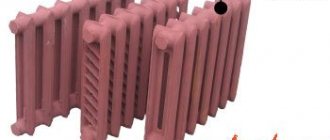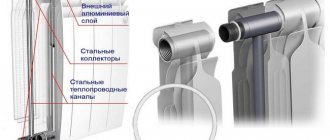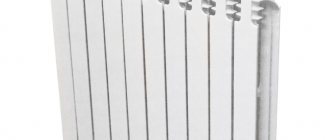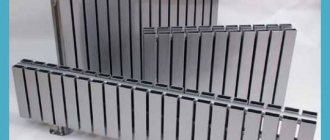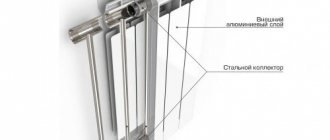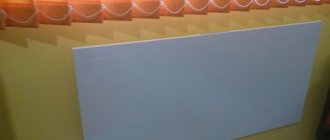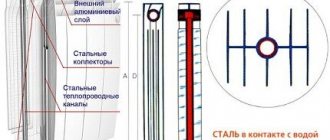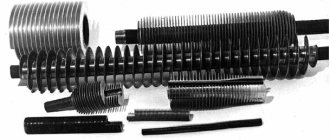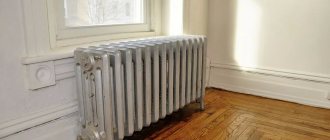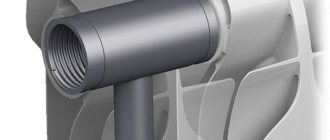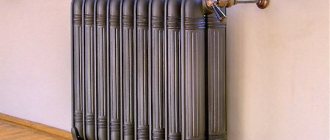Features of the MS-140-500 radiator
Cast iron radiators MS-140 with a center distance of 500 mm are designed for heating buildings of any purpose, from private residential buildings to industrial and production buildings.
They have good heat transfer and resistance to aggressive coolants. Cast iron “accordions” stubbornly do not want to leave the heating equipment market, since they are considered the most unpretentious type of radiators. Cast iron batteries are among the most durable. This is due to the physical and chemical properties of the metal.
The main advantage of cast iron batteries is their long service life. Cast iron reluctantly reacts with water and aggressive compounds, resisting corrosion well. The top layer, protected by primer and paint, is also not susceptible to it. Even in the absence of external protection, cast iron practically does not deteriorate or become thinner. It gets to the point that in some cases these radiators can outlast the building itself in terms of service life.
The heat output of MS-140 cast iron radiators with center distance ranges from 140 to 185 W per section. This is a pretty decent indicator, which allows cast iron to successfully compete with other types of heating batteries. Today, cast iron batteries are produced by many domestic factories and are not going to leave the shelves of plumbing stores.
Thanks to modern cast iron casting technologies, the finished products are especially durable and do not require too frequent maintenance.
Differences in the technical characteristics of cast iron heating batteries from other popular types of batteries.
What are the advantages of cast iron radiators MS-140-500?
- Resistance to aggressive coolant - centralized heating systems do not spare even the most durable modern radiators. Cast iron practically does not react with caustic and aggressive compounds;
- Large internal capacity - thanks to this, radiators almost never become clogged or clogged. Also, the internal volume helps reduce hydraulic resistance;
- Long service life - manufacturer's warranty reaches 10-20 years. As for the actual service life, it is up to 50 years and even more, you just need to properly care for the batteries and tint them on time;
- Long-term heat retention - if the heating is turned off, cast iron will retain and release heat for a long time, heating rooms and rooms;
- Affordable cost - the price for cast iron radiators MS-140-500 starts at 350-400 rubles per section (depending on the manufacturer).
Let's list a few disadvantages:
One of the main disadvantages of cast iron batteries is their instability to water hammer; here they are inferior to their bimetallic counterparts.
- Heavy weight is perhaps one of the most important disadvantages. One section weighs over 7 kg, which is why the weight of a 10-section battery is over 70 kg;
- Difficulty in installation - if you can install aluminum or steel radiators yourself, then two or three people will have to work on a cast-iron radiator. In addition, for fastening to the wall you need good, durable fasteners (and the walls themselves should not crumble under the weight of the batteries);
- Lack of resistance to high pressure - cast iron batteries are intended for use as part of autonomous heating systems (installation in low-rise buildings connected to centralized systems is allowed).
We can also highlight as a disadvantage of cast iron batteries MS-140 their high inertia - a lot of time passes from supplying coolant to warming up the system.
Despite the presence of some shortcomings, cast iron batteries continue to be in steady demand - consumers are captivated by the optimal combination of price, quality and technical characteristics.
Cast iron radiators MS-140 can be used as part of autonomous and centralized heating systems with a maximum coolant pressure of up to 9-10 atmospheres. The coolant temperature can reach +120-130 degrees - cast iron remains resistant to such temperature overloads. The main thing is not to subject it to strong impacts, otherwise it may break.
MS-140 radiators can be used in systems with natural and forced coolant circulation. The system can be open or closed - cast iron can work in any conditions. The main thing is that the heating parameters do not exceed the values specified in the passport data. The difficulty in operation is caused only by the need for regular maintenance - monitor the condition of the paint coating and prevent the formation of pockets of corrosion.
Technical characteristics of cast iron batteries
Of course, the most important parameters of heating structures are characteristics such as thermal output and power. Manufacturers prescribe power indicators in the technical documentation and, what is important, for a single section.
On average, the sectional power of a cast iron heating radiator is 160 W.
The thermal output of cast iron structures is two times worse than that of aluminum or bimetallic ones. However, this disadvantage is due to slight inertia. Cast iron is able to retain thermal energy much longer. These heating structures show themselves most effectively in systems with natural circulation of liquid.
Power of cast iron heating radiators and its comparison with other types of batteries.
| Radiator type | Heat transfer of one section, W | Working pressure, bar | Crimping pressure, bar | Section weight, kg | Section capacity, l |
| Cast iron with a gap between the axes of sections of 500 mm | 160 | 9 | 15 | 7,12 | 1,45 |
| Cast iron with a gap between the axes of sections of 300 mm | 140 | 9 | 15 | 5,4 | 1,1 |
| Bimetallic with a gap between the axes of sections 500 mm | 204 | 20 | 30 | 1,92 | 0,2 |
| Bimetallic with a gap between the axes of sections 350 mm | 136 | 20 | 30 | 1,36 | 0,18 |
| Aluminum with a gap between the axes of sections 500 mm | 183 | 20 | 30 | 0,27 | 0,27 |
| Aluminum with a gap between the axes of sections 350 mm | 139 | 20 | 30 | 1,2 | 0,19 |
Another important parameter is the weight of cast iron heating radiators. One section weighs from 3 to 7 kilograms. The number of sections is different for each model. Much depends on the chosen model, as well as the size of the heated room. After the fasteners for cast iron heating radiators have been installed, sections can be added or removed as desired.
An equally important indicator is the size of the battery. The width of one section is from 8 to 10 cm, the height is from 37 to 57 cm, the depth is from 7 to 12 cm.
The volume of space from the inside can be 0.7-1.5 liters.
It is worth mentioning the working pressure. This is the load exerted by the liquid during circulation through the heating system. Typically the values are 6-10 atmospheres.
Maximum operating pressure. This is the load at which the battery can operate during a period of heavy water impact. When checking the heating system, a load is created inside the lines that is very close to the maximum. New cast iron models can withstand pressure of 12-18 atmospheres.
The average service life of cast iron heating radiators is 30 years. Of course, with careful treatment and favorable conditions, structures can last 60 years. This is a pretty good indicator, which is much higher than that of modern aluminum or bimetal batteries. Such a long service life of cast iron heating radiators is due to the considerable size of the internal channels, which prevents clogging from the inside.
Materials and technical characteristics of cast iron radiators MS-140-500
To tighten the radiator sections, there are left and right threads on the nipple from opposite ends. The material from which the nipples are made is malleable cast iron grade KCh30-6-F according to GOST 1215-79, steel 08 KP or 08 PS according to GOST 1050-2013.
The nipple is installed between the sections. Its rotation is carried out using a key with a straight tip. Due to the fact that the nipple is threaded in different directions, the sections are pulled together. It is accessed through the open radiator hole.
The resulting connection is sealed using an annular gasket. Gasket material – heat-resistant rubber ITP or ITC, corresponding to TU 38 105376-82, or ring 9833-73 / 18829-73.
If it is not possible to install a rubber gasket, it is possible to seal the joints using tow.
Tow is impregnated with red lead or drying oil. The end of the radiator battery is closed with a plug made of gray cast iron SCh 10 GOST 1412-85. Table 1. Technical characteristics of radiators MS-140-500
| Manufacturer / Characteristics | Minsk Heating Equipment Plant | OJSC "Santekhlit", Bryansk region | Nizhny Tagil boiler and radiator plant Novosibirsk (Russia) | Lugansk Foundry and Mechanical Plant (Ukraine) | |
| Marking | MS-140-500 | MS-140-500-0.9 | MS-140-M2-500 | MS 140/500 | MS-140-M4-500-0.9 |
| Height, mm | 588 | 590 | 580 | 588 | 588 |
| Width, mm | 108 | 98 | 90 | 93 | 98 |
| Depth, mm | 140 | ||||
| Weight, kg | 7,12 | 6,25 | 6,25 | 7,1 | 6,74 |
| Distance between hole centers, mm | 500 | ||||
| Through hole size, inch | 5/4 | ||||
| Water volume in section, l | 1,45 | 1,45 | 1,4 | 1,45 | 1,33 |
| Number of channels in a section | 2 | ||||
| Permissible coolant temperature, degrees. | 130 | ||||
| Heat transfer value of the section, W (t=70 degrees) | 185 | 160 | 160 | 160 | 184 |
| Warming up area per section sq.m. | 0,244 | ||||
| Permissible coolant acidity, pH | 6–9 | ||||
| Test pressure, MPa | 1,5 | 1,5 | 1,8 | 1,5 | 1,6 |
| Working pressure, MPa | 0,9 | 0,9 | 1,2 | 0,9 | 0,9 |
These models can be used with almost any type of coolant that meets acceptable acidity standards.
What it is
Description
A sectional battery made of gray cast iron with cast iron or steel connecting nipples and intersectional gaskets made of paronite is sold under the name cast iron radiator MS-140M-500 (MS-140-500).
The properties of the product are quite common for cast iron heating devices:
- Significant mass and, as a consequence, high thermal inertia;
- Solid capacity per section, again increasing thermal inertia;
- Relative fragility (gray cast iron is not resistant to impact loads);
- Moderate resistance to internal pressure.
Fastening elements are not included. Depending on the choice of brackets, the device can be mounted on the wall or installed on the floor.
Let's face it: the batteries in the photo are not a masterpiece of design.
Characteristics
Technical characteristics of the MS-140-500 radiator are given on the websites of numerous manufacturers and sellers. We will publish them too.
| Parameter | Meaning |
| Number of channels for coolant in a section | 2 |
| Heat flow per section at a temperature difference between the battery and air of 70 degrees | 160 W |
| Permissible maximum coolant temperature | 130 C |
| Section material | Gray cast iron SCh10 GOST1412-85 |
| Material for making nipples | Malleable cast iron GOST1215-79 |
| Gasket material | Heat-resistant rubber (paronite) 1T-P, 1T-S according to TU38-105376-82 |
| Operating pressure | 9 kgf/cm2 |
| Test pressure | 15 kgf/cm2 |
| Section length (including gasket thickness) | 108 mm |
| Section height | 588 mm (500 along nipple axes) |
| Depth (distance from front to back surface) of section | 140 mm |
| Nipple/Manifold Thread Size | DN32 /1 1/4 inches) |
| Section capacity | 1450 cm3 (1.45 liters) |
| Section weight | 7.12 kg |
| Section price | 300 – 400 rubles |
Cast iron batteries will get along well with a solid fuel boiler. The considerable weight of cast iron batteries was reflected in Soviet cinema.
Methods for installing a cast iron radiator
Since cast iron radiators have considerable weight, when choosing a model it is better to think about the installation method in advance. The battery can simply be placed on the legs. Many designer radiators are already available with legs. If we are talking about other models, then you can also select and purchase legs for them separately.
If you plan to attach the battery to the wall, then it is recommended to do this on a load-bearing wall. You can mount the heating device on the partition, but first it must be further strengthened. To do this, the fastenings must be as reliable as possible. It is better to use hooks or brackets.
Installation of a cast iron radiator
Sources
- https://teplosten24.ru/teplootdacha-chugunnyh-radiatorov-ms-140.html
- https://fb.ru/article/281193/ms—-radiator-chugunnyiy-harakteristiki-obzor-vidyi-i-otzyivyi
- https://fb.ru/article/283114/ms–m—-radiator-chugunnyiy-harakteristiki-preimuschestva-i-nedostatki-proizvoditel
- https://gopb.ru/radiatory/kakie-luchshe-chugunnye-radiatory-otopleniya-ms-140m-500-ms-110-500-ms-110-300-texnicheskie-xarakteristiki/
Calculation of cast iron heating radiators per area
Familiarize yourself with the main parameters that need to be taken into account when calculating. They include thermal power for heating 1 m² - 100 W, standard ceiling height - 2.7 m, one external wall.
It turns out that the thermal power required to heat a room of 10 m² is 1000 W.
The resulting power is divided by the thermal output of one section and the required number of sections is determined.
Calculation table for cast iron heating radiators per area.
| Heating area, m² | Power, W |
| 5-6 | 500 |
| 7-9 | 750 |
| 10-12 | 1000 |
| 12-14 | 1250 |
| 15-17 | 1500 |
| 18-19 | 1750 |
| 20-23 | 2000 |
| 24-27 | 2500 |
You can read about designer cast iron radiators on this page.
Why else should you choose a cast iron battery?
Heating devices made of cast iron also provide radiant heating, which distinguishes them favorably from steel and aluminum devices. Heat is distributed into the environment by infrared radiation. Objects begin to transfer heat into the air space, acting as additional heating sources.
If necessary, such devices can be disassembled when it is necessary to install a device of the required thermal power. Sections can be added or removed if necessary, and the internal walls can also be cleaned. Another advantage is the affordable price, which varies from 400 to 500 rubles. As you know, price is a factor that sometimes influences the final choice of the consumer. If you are still undecided which radiator to prefer, then it is necessary to clarify the fact, which indicates that some positive qualities can sometimes look like disadvantages. They will be discussed below.
Video
The video contains instructions on how to disassemble, clean and assemble a Tefal iron yourself:
About the author:
Electronic engineer with many years of experience. For several years he was involved in organizing the repair of household appliances, including washing machines. Loves sport fishing, water tourism and travel.
Found a mistake? Select it and click the buttons:
Ctrl + Enter
Interesting!
Astronauts, while in Earth orbit, solve the problem of dirty things using an original method. Clothes are dropped from the spacecraft and burn up in the upper atmosphere.
How to choose a cast iron radiator
What radiator performance characteristics should you pay attention to when choosing radiators? First of all this:
- operating pressure;
- operating temperature in the heating system for which heat transfer is calculated;
- heat transfer;
- heat-emitting surface area;
The first of these indicators determines the coolant (water) pressure that the radiator can withstand. The higher the number of floors of a building, the stronger it should be. The second indicates at what temperature the coolant is supplied to the radiator and at what temperature it leaves it for subsequent heating. So the indicator 90/70 means that the water entering the first section of the battery has a temperature of 90 degrees. and coming out of its last section - 70 degrees. Heat transfer is an indicator indicating how much heat the radiator section gives off during the time the water in it cools from the inlet temperature (for example, 90 degrees) to the outlet temperature (for example, 70 degrees).
The shape of the purchased radiator deserves special attention. It is no secret that the prejudice against cast iron radiators is caused by the fact that when they are mentioned, many people remember the “cast iron accordion” under the window, which they have become accustomed to since childhood. Indeed, the usual “finned batteries” have a small and ineffective heating surface area (heat transfer) - for example, for a section of the familiar MS 140 radiator, this figure is 0.23 sq.m.
Part of the heat of the incoming coolant is lost “on the way” from the heating boiler to the water heating battery, because massive supply pipes are used for such systems. In addition, to heat water to a design temperature of 90 degrees. Only high power steam boilers are suitable. Therefore, in private homes the heating system sometimes operates at a lower temperature.
However, modern cast iron radiators, both in appearance and, accordingly, in parameters, can differ significantly from their “accordion” predecessors. While retaining all the advantages of traditional cast iron batteries, it is devoid of many of their disadvantages. Thus, the Minsk-made 1K60P-500 radiator is assembled from flat plates, each of which has a small heating area (0.116 m2) and low power (70 W).
However, a radiator assembled from them is essentially a heating panel, which (unlike finned batteries) produces a wide directed heat flow. Other manufacturers also provide a wide selection of such radiators.
The advantage of modern cast iron radiators is that many models allow batteries of the required power to be assembled from separate sections.
Radiators sold assembled (for example, Conner, STI Breeze and some others) are formed from a number of sections designed for rooms of various sizes based on an engineering calculation of the required thermal power per square meter of room.
For example, you can purchase one radiator of 4-6-8-12 sections or two radiators of 4 (6, 8 sections).
Real heat transfer of the radiator section
As already indicated, the power (heat transfer) of radiators must be indicated in their technical passport. But why, a few weeks after installing the heating system (or even earlier), does it suddenly turn out that the boiler seems to be heating as it should, and the radiators are installed according to all the rules, but it’s cold in the house? There may be several reasons for a decrease in the actual heat transfer of radiators.
Cast iron radiator Viadrus (Czech Republic)
We present the indicators of the heating surface and the declared heat transfer for the most common models of cast iron radiators. We will need these figures in the future for examples of calculating the real power of the radiator section.
| Radiator type | Heating surface, m2 | Heat dissipation, W m2 (90/20°C) |
| M-140-AO | 0,299 | 175 |
| M-140-AO-300 | 0,17 | 108 |
| M-140 | 0,254 | 155 |
| M-90 | 0,2 | 130 |
| RD-90s | 0,203 | 137 |
As already mentioned, when using such radiators for medium- and low-temperature heating systems (for example, 55/45 or 70/55), the heat transfer of a cast-iron heating radiator will be less than that stated in the passport. Therefore, in order not to make a mistake with the number of sections, its actual capacity must be recalculated using the formula:
K is the heat transfer coefficient;
F is the heating surface area;
∆ t - temperature difference °C (0.5 x ( tin. + tout. ) - tin.);
tin – temperature of water entering the radiator,
tout – water temperature at the radiator outlet;
tin. - average air temperature in the room.
When the temperature of the incoming coolant is 90 degrees, the outlet temperature is 70 degrees, and the temperature in the room is 20 degrees.
∆ t = 0.5 x (90 + 70) – 20 = 60
The K coefficient for the most common cast iron radiators can be found here:
| Thermal pressure | 50-60 | 60-70 | 70-80 | 80-100 |
| Heat transfer coefficient (K) | ||||
| High cast iron radiators | 7.0 | 7.5 | 8.0 | 8.5 |
| Medium cast iron radiators | 6.2 | 6.4 | 6.6 | 6.8 |
Even the actual heat transfer of one section of an average cast iron radiator with an area of 0.299 sq. m (M-140-AO) with an incoming water temperature of 90 degrees and an outlet water temperature of 70 degrees will differ from the declared one. This occurs due to heat loss in the supply pipes, and for other reasons (for example, reduced pressure), which cannot be foreseen in laboratory conditions.
So, the heat transfer of a section with an area of 0.299 sq. m. at a temperature of 90/70 will be:
- 7 x 0.299 x 60 = 125.58 W
Considering that heat transfer is always indicated with some margin, we multiply this figure by 1.3 (this coefficient is used for most cast iron radiators) and we get: 125.58 x 1.3 = 163.254 W - compared to the declared 175 W.
There will be an even greater difference in the numbers if the water entering the radiator does not heat above 70 degrees. (and the exiting coolant, accordingly, cools down to 60-50 degrees), so before buying new radiators, it is advisable to find out the real thermal parameters of your heating system.
How to save on heating?
The first rule of reasonable saving is to remember what you should never save on! Radiators should always be taken with a reserve, because you can reduce the temperature in the room by reducing the temperature of the water in the system or using shut-off valves. But if the actual heat transfer turns out to be lower than that declared by the manufacturer, the rooms will be cool at best. By the way, Conner cast iron radiators, which are quite good in most respects in terms of actual operation, have a heat transfer rate that is 20-25 percent lower than indicated in the data sheet.
Radiator 1K60P-500 (Minsk)
As already indicated, heat transfer may differ from the declared one due to the fact that the water temperature in the heating system is much lower than the “standard” one, that is, the one at which factory tests were carried out, since the declared radiation power is achievable only under laboratory conditions. Imagine that the MS-140 radiator section (160 W power indicated) at a water temperature of 60/50 degrees. (and the “boiler can’t handle any more”!) will produce a power of no more than 50 W. And if you believed the technical data sheet and decided to install 5 heating sections, then instead of 800 W (160 x 5) you will get only 250.
How much does a section of an old-style cast iron battery weigh?
The classic cast iron accordion battery can be found everywhere. There is no single weight for such a battery, because several types of factory designs were produced. The cast iron radiator MS-140 had two varieties regarding the center distance: 300 mm and therefore 500 mm. The average weight of one radiator fin is 5.7 kilos. But if we talk about the MS-140 (500) radiator, then the weight of the fin reaches 7.1 kg.
The battery installation must meet the following requirements:
- The battery fins must be strictly vertical;
- The center of the radiator from the center of the window should not deviate more than 2 cm;
- The distance from the floor to the radiator itself must be at least 60 mm, otherwise it will be extremely difficult to clean underneath it.
The distance from the plane of the radiator to the window sill should not be more than 5 cm. This will be convenient, if necessary, to repair the battery and care for it. And dismantling will be convenient when it’s time to change the battery.
Foreign cast iron radiators
Foreign-made cast iron batteries are made in modern or retro style. The latter have more weight due to inlay and artistic elements. As a rule, they can be installed on the floor.
Viadrus Termo (Czech Republic)
Without water
- 500/95 – 4.35;
- 500/130 – 5,35;
- 623/95 – 5,1;
- 623/130 – 6,45;
- 813/95 – 6,7;
- 813/130 – 8,8.
With water
- 500/95 – 4.95;
- 500/130 – 6,15;
- 623/95 – 5,9;
- 623/130 – 7,45;
- 813/95 – 7,7;
- 813/130 – 10,1.
Carron (England)
- The Chelsea 675/67 – 13.3;
- The Daisy – 11.3;
- The Orleans - 17.3;
- The Rococco – 16.6;
- The Verona – 14.3.
Carron Chelsea cast iron radiator.
Demrad Ridem (Türkiye)
- 2/813 – 5,15;
- 3/350 – 3,37;
- 3/500 – 4,8;
- 3/623 – 5,5;
- 3/813 – 7,05;
- 4/500 – 6,15;
- 4/623 – 7,25;
- 4/813 – 8,95.
Demrad Retro (Türkiye)
- 350/76 – 8,6;
- 500/76 – 11;
- 600/76 – 11,5;
- 800/76 – 13,5.
Cast iron radiator Demrad Retro.
When taking into account the mass of a cast iron radiator, you should not forget about additional loads - taps, plugs, pipes. If the battery is located far from the riser, the weight of the water pipe can place a significant additional load.
Do you want to get help from a master, a specialist in this field? Go to the professional search portal. This is a completely free service where you will find a professional who will solve your problem. You do not pay for posting an ad, views, or choosing a contractor. If you are a master of your craft, then register on Pro and receive a flow of clients. Your profit is just one click away!
Installation instructions
The MS-140-500 radiator, the installation instructions for which will be described below, can be chosen by you as a heating device. The most difficult stage of the work will be connecting the device to the general house system. Therefore, you should contact the housing office that maintains the house.
You should first prepare the place where the radiator will be installed. For this purpose, fastenings are mounted at one level, where the cast iron battery will be hung. You can paint the radiator only after installation and connection, otherwise the work will have to be done twice. The sections should be connected to each other using nipples, which are a cylindrical coupling with counter-directional threaded sections. Gaskets are installed between the sections. To engage with the splines, special beads located on the inner surface of the nipple will be required.
Main advantages
Cast iron radiators, the price of which is one of the advantages, were invented quite a long time ago, but to this day they continue to be in demand, due to their operating efficiency and corresponding quality characteristics. In addition, a better option in this line has never been invented.
But any device, like a cast iron battery, has its own advantages and disadvantages, which will be discussed below. Among the advantages are:
- unconditional reliability;
- high heat capacity;
- Possibility of use in autonomous and central heating systems.
If you want to choose a truly high-quality and durable device, then you should prefer the MS-140M-500 - a cast iron radiator, the characteristics of which you could read above. It is ready to serve for more than 50 years, this is exactly the period that manufacturers give for the operation of this device. If you take proper care of the unit, it will last much longer.
These radiators are also preferred for the reason that cast iron has a high heat capacity. This characteristic is important when, after a shutdown, there is a need to retain heat indoors for a long time. These devices are ready to withstand pressures of up to 9-12 atmospheres, which is important for devices operating in central heating systems, where water hammer is frequent and can damage the integrity of batteries with thin walls. This is why the cast iron version is so common in apartments in multi-storey buildings.
When the assembly has been carried out correctly, the cast iron radiator will easily withstand water temperatures up to 130 °C. In this case, the coolant can be of any quality. MS-140M-500 is a cast iron radiator, the characteristics of which must be studied before purchasing the product; it has fairly wide internal channels that rarely become clogged. This feature makes it possible to prevent sections from breaking during hydraulic shocks.
Advantages of cast iron batteries
Let us list the positive qualities of such devices:
- Cast iron is a metal with high anti-corrosion properties. This feature allows the use of such heat exchange equipment for 50 years, without making any special efforts to maintain. No analog device can even come close to such high performance indicators.
- The design of the cast iron radiator is such that it creates minimal resistance to the coolant. These devices can be installed even where there is minimal hydraulic pressure.
- Cast iron can retain heat for a long time even when the hot water supply stops. Due to its high thermal inertness, the material completely releases its thermal energy.
- The temperature of the coolant is also “radiated” into the space in full, so we can safely say that a cast iron radiator is very effective.
What explains the popularity of cast iron models?
Height, length and width of the radiator
It is too early to say that the era of cast iron radiators has already passed. Such devices will be used throughout the post-Soviet space for a long time. And that's why.
It is this heat exchange equipment that is ideal for operating a central heating system. Aluminum and steel radiators cannot be installed in apartment buildings. They fail very quickly, not even fulfilling the warranty period stated by the manufacturer. The reason is the low quality of the coolant.
Water in most of Russia has an alkaline environment, which is detrimental to “pure” aluminum. Often in central systems, salts and acids are added to the coolant to reduce its heat losses. Alkali, when reacting with aluminum, produces a substance that destroys the brittle metal. Over time, an aluminum radiator becomes like a porous sponge, which can easily break from the first water hammer.
With steel batteries the situation is slightly different. They are able to withstand any quality of coolant, but steel does not tolerate oxygen. As soon as it appears in the system, corrosion processes begin to develop sharply. To avoid this, a steel radiator should always be completely filled with water. If connected to a central heating system, this is difficult to achieve. Usually in summer the water from the systems is completely drained.
The choice remains - either use expensive bimetallic analogues (but due to the high price, not everyone can afford these products), or install time-tested cast iron radiators. And even though they look bulky, and their appearance is difficult to fit into modern interiors, such heat exchange equipment is reliable, efficient and durable.
Technical characteristics of MS 140 batteries
For the manufacture of this type of radiators, an entire GOST 8690–94 was developed at one time, regulating all parameters of the product. In accordance with it, 5 standard sizes of batteries were produced with center distances of 300, 400, 500, 600 and 800 mm. The table below shows cast iron heating radiators with technical characteristics of dimensions in accordance with GOST 8690.
Previously, all standard sizes of these devices could be seen not only in apartments, but also in industrial or administrative buildings. It is advisable to review the characteristics of the two most popular standard sizes: 300 and 500 mm, which are still in demand. Other modifications are now very rare, and they are made only to order.
The main technical characteristics of the cast iron radiator MS 140 with center distances of 300 and 500 mm are reflected in the following table.
Having studied all the characteristics, we can draw conclusions about the advantages and disadvantages of the heating devices in question. Their advantages are as follows:
- Durability. It is at least 30 years old.
- Heat dissipation. Despite its outdated design, the cast iron radiator MC 140 shows good thermal power values.
- Unpretentiousness. The gray cast iron from which the devices are made is not subject to corrosion and easily tolerates poor coolant with a high oxygen content.
- Low maintenance. It is not superfluous to flush the channels of the product once every 2 years, but if this is not done, then the MS 140 will continue to work safely. Only the heat transfer rate will begin to decrease.
- Inertia. It is both a plus and a minus of batteries. The advantage is that after the heating is turned off, the device continues to radiate heat into the room for a long time.
- Affordable price.
Now about the shortcomings, of which there are also many. The same inertia of the devices causes them to heat up for a long time and excludes the possibility of regulation using thermal heads. There are others:
- Large coolant capacity. This affects the rate of heating and cooling of the system, and also forces a lot of thermal energy to be spent on heating a large volume of water.
- The considerable weight of the products affects the installation of radiators. They are very difficult to mount on walls made of porous lightweight materials, which are very popular nowadays.
- Low operating pressure threshold. This makes it impossible to install it in high-rise building systems.
- Fragility. The wall-mounted cast iron radiator MC 140 500 is shock-resistant because it has thin walls. It cracks at the slightest freezing of water from frost.
- Unpresentable appearance compared to more modern analogues of cast iron batteries.
Kinds
A cast iron heating radiator, like any other, has a design of several similar sections. They are made in factories using the casting method from gray cast iron.
The channels, which are designed for coolant circulation, have either the shape of a circle or an ellipse. Already at the time of assembly, all sections of the future radiator are connected to each other using nipples, and the joints of the structures are once again sealed. Temperature-resistant rubber or paronite gaskets are used. This is how cast iron heating radiators are assembled at the factory.
Types of cast iron heating radiators:
- single-channel;
- two-channel.
Structures can be of different widths, depending on the number of sections, and have different weights and heights. The width dimensions of cast iron heating radiators depend on the volume of the room that will be heated, on the number of windows, as well as the thickness of the walls facing outside. It is clear that if a larger number of sections are used in the radiator, then more heat will be released. Height can vary from 35 centimeters to 1.5 meters. The depth of the heating structure also matters. It depends on whether the radiator will fit the interior. The depth can be 50-140 centimeters or more.
To carry out installation, you will need a bracket for cast iron heating radiators. The bracket must be securely fastened to the wall. It happens that structures of large weight are hung under the window opening on brackets and positioned in such a way that it recedes a short distance from the wall. Although currently on the heating equipment market you can find new models that are installed on the floor and have legs.
Another modern option is tubular cast iron heating radiators. These are aesthetic and efficient premium designs that meet all requirements and offer many advantages.
Cast iron heating radiators Konner
Attaching the toilet to the floor on tiles: step by step
The installation process will vary slightly depending on the type of installation you choose. For example, to install a toilet with an open mount, you need to do the following:
- We install the structure in the intended location.
- Using a marker, make marks on the tile where the fasteners will be installed. The marker must be vertical, otherwise there is a risk of the marks shifting, which will cause incorrect installation.
- We move the toilet. In the place where the marks remain, we make holes (use a drill).
- We take a core and scratch the tile coating (this is necessary to avoid the drill from sliding on the tile).
- First we use a drill designed for glass.
- As soon as we have overcome the glass layer of the tile, we take a drill for concrete.
- We make a hole of the required depth. The size depends on the mounts purchased.
- The finished hole is cleared of debris.
- Fill the hole with sealant. This will protect the installation from moisture.
- After adding sealant to the holes, you can insert the installation.
- Now we install the toilet. It is also necessary to make a strip of sealant along its contour to protect the base from moisture.
- Elements are inserted into the mounting holes. We twist them.
- To protect the installation from water, as well as to give them an aesthetic appearance, plugs can be placed on the bolts.
- The remaining sealant is removed with a staple.
If we chose internal fastening, we do the following:
- Before fixing the product, it is necessary to make holes for water supply and sewerage.
- As in the open installation method, work begins with creating marks on the tiles.
- Drill the necessary holes. We place hidden fasteners on the floor.
- After installing the fasteners on the floor, they must be secured with bolts.
- We install the empty part of the toilet onto the fasteners.
- We secure the structure with bolts through the side holes.
- You should not tighten the bolts all the way, as there is a chance that you will have to slightly adjust the position of the toilet to secure it to the water and sewer line.
Anyone can install a toilet on tiles, the main thing is to follow the instructions.
Peculiarities
So, what conclusions can be drawn by studying the technical characteristics of the MS-140-500 cast iron radiator?
- Slow heating and equally slow cooling make the device an excellent choice for an autonomous system with a solid fuel boiler. Inertia will smooth out fluctuations in coolant temperature during infrequent kindling.
- Wide internal channels of sections and collectors, coupled with a large diameter of the connecting thread, will allow it to be used in gravity systems. Thanks to these features, MS-140 will create minimal hydraulic resistance to flow.
- Despite the many years of use of this heating device in central heating systems, the characteristics of the cast iron radiator MS-140M-500 do not allow us to recommend it for these purposes with a light heart. The key word is water hammer: at the front of the area of increased pressure spreading along the contour there can be 20 or 25 atmospheres, for which the device is not designed. Yes, water hammer is an abnormal situation, but, believe the author’s experience, it is quite common in the real world.
Consequences of water hammer.
Properties of radiators MS 140
Simplicity of installation and repair, high performance characteristics, as well as good heat dissipation - all this makes MC 140 radiators a popular product among both wholesale and retail customers. In addition, similar products were installed back in Soviet times. Therefore, they have been repeatedly tested for strength and serve their owners to this day, enjoying their trust.
The peculiarity of sectional cast iron radiators of this brand is their resistance to aggressive environments. In addition, they have a classic design that is appropriate in any interior. And such equipment can be used in heating systems not only in residential buildings, but also in public and industrial facilities.
Advantages of devices
It is worth noting the following advantages of the device:
Characteristics of Breeze 500
- Expanded cross-section of water channels, due to which the service life of the radiator is significantly increased.
- High level of thermal conductivity, as well as durability and reliability. Cast iron is a wear-resistant material that is not harmed by small stones or various debris found in the coolant. For high-quality radiators, the service life can reach up to 50 years. However, manufacturers talk about 30 years of reliable use without cleaning or repair.
- Good anti-corrosion characteristics. They are ensured due to the fact that during use the surface of the cast iron radiator is covered with “dry rust”, which does not give corrosion the slightest chance.
- Convenient ability to replace sections.
- Cast iron under no circumstances can cause electrochemical corrosion. This means that there will be no problems when using such radiators with plastic or steel pipes.
In addition, cast iron batteries are best suited for Russian consumers, given the qualitative composition of the coolant circulating through centralized heating networks. Not every aluminum or bimetallic radiator can withstand the quality of the coolant for at least 10 years, but cast iron ones do this for more than 30 years.
Flaws
Decorative pattern
Among the disadvantages are:
- solid weight of the structure;
- high heat inertia;
- possibility of damage to the system due to water hammer.
In addition, due to the large mass of the radiator, difficulties may arise during the installation process or when transporting the equipment.
Weight of imported cast iron radiators
Today, many models of domestic imported production have been put into operation, all of them are classified differently. Many modern cast iron batteries are designer, imitation in retro style. They can repeat classic designs in functionality and dimensions, but are significantly superior in aesthetics, adding weight due to artistic soldering or molding of patterns. Many initially have legs for floor mounting, such as Viadrus Termo (Czech Republic).
Without water, the weight of 1 section of an imported cast iron radiator (indicating dimensions):
| Dimensions | Weight, kg |
| 500/95 | 4,35 |
| 500/130 | 5,35 |
| 623/95 | 5,1 |
| 623/130 | 6,45 |
| 813/95 | 6,7 |
| 813/130 | 8,8 |
Sections filled with coolant:
| Dimensions | Weight, kg |
| 500/95 | 4,95 |
| 500/130 | 6,15 |
| 623/95 | 5,9 |
| 623/130 | 7,45 |
| 813/95 | 7,7 |
Cast iron radiators MS-140
i http-equiv="Content-Type" content="text/html; ″>d=”breadCrumb”> Home page»Radiators»Cast iron radiators» MS-140
| MS-140-500 price list MS-140-300 price list |
MS-140 is a two-channel heating device consisting of separate cast iron sections connected to each other by nipples with rubber or paronite gaskets. The large cross-section of the channels allows the coolant to circulate inside the radiator without additional effort, which makes it possible to use it in systems with natural circulation, in the so-called gravity heating systems.
Cast iron radiators have significant thermal inertia, i.e. They react poorly to changes in coolant temperature, take a long time to heat up and take a long time to cool down, so the use of this type of heating devices in heating systems where a weather-dependent or other thermoregulation mode is used is inappropriate.
MS-140 heating radiators are quite heavy and have a rather unattractive design, however, the demand for these heating devices does not weaken due to their availability, both in terms of price and in terms of ease of maintenance and durability. They are supplied primed or painted on pallets with 10 radiators each: 9 radiators in 7 sections and one radiator in 4 sections. If it is necessary to assemble heating devices with a different number of sections from the base, subsequent pressure testing of the radiators is required. Depending on the manufacturer, MS-140 radiators can have an operating pressure of up to 12 atm, a test pressure of up to 18 atm, a nominal heat flux of one radiator section of up to 175 W, and a maximum coolant temperature of up to 130°C.
The main manufacturers and suppliers of cast iron radiators MS-140 to the Russian market are the following enterprises:
Minsk Heating Equipment Plant - the most popular product on the Russian market is Minsk cast iron radiators MS-140. However, in addition to standard radiators, the plant produces heating devices of the following modifications: cast iron design radiators 1K60P-500, radiators with reduced front clearance between sections and improved design 2K60, 2K60P, 2K60PP, 2KPM-90x500, 2KP100-90x500. The above heating devices differ from traditional MS-140 radiators, in addition to their design, in their smaller depth, capacity and higher operating pressure.
Lugansk Foundry-Mechanical Plant is an enterprise that also produces a wide range of competitive products of European quality: traditional cast iron radiators MS-140 with center-to-center distances of 500mm and 300mm; compact, similar in design to KONNER cast iron radiators, heating devices RK-1-100-500; compact and lightweight three-channel cast iron radiators MS - 100 M1 3KP 500 and MS - 100 3KP 300 with center-to-center distances of 500 mm and 300 mm, respectively.
Cheboksary Cast Iron Radiator Plant - the plant produces both traditional MS-140 radiators and modified CHE.RAD radiators, which have a more attractive design, compact size and lower capacity. A special feature of these heating devices is the presence in the model range of 2- and 3-channel radiators with a depth of 102 mm and 120 mm, respectively.
Lyubokhonsky Iron Foundry - produces cast iron radiators MS-140, MS-110, MS-85. A special feature of the model range is the presence of radiators with a depth of 110mm and 85mm. These are compact heating devices with a higher - 12 atm - excess pressure and an updated design. Radiators are supplied primed and painted.
Nizhny Tagil Boiler and Radiator Plant - the enterprise produces traditional radiators MS-140 with a center-to-center distance of 500mm and 300mm - MS-140M2-500 and MS-140M-300 with heat output of 160W and 117W, respectively, as well as a model of cast iron sectional radiators T90 - heating devices with improved design, depth 90mm, center distance 500mm and heat output 127W per section. All NTKRZ radiators are supplied assembled in 4 and 7 sections in a primed form.
| Conner | Guratec | Sti | Che.Rad |
| Home | 2003 kck20 |
General provisions
First of all, let's look at the pros and cons of cast iron batteries:
Advantages
- Resistance to corrosive processes . You can rest assured that even during summer periods, when the liquid is drained from the system, the cast iron will stand.
- Unpretentiousness to the quality of the coolant , which is very important for apartment heating systems, where you cannot control the composition of the liquid running through the pipes from the central boiler room.
- Durability . The service life is at least 35 years.
An old cast iron radiator with 7 sections has been successfully heating the apartment for decades
- Low price . Especially in comparison with newer aluminum and bimetallic models.
- High heat dissipation . Combined with a large area, you get a powerful heating device for your home.
- Simple operating instructions . After installation and application of paint, you can forget for a long time about the need for any maintenance of the cast iron structure.
- Slight inertia . Even after turning off the heating, cast iron radiators will remain warm for a long time.
Flaws
- Heavy weight. This is one of the biggest problems that arise when installing cast iron radiators with your own hands. The weight of one battery, depending on the number of sections, can vary from 50 kg to 150 kg, which will create incredible difficulties even when simply hanging a cast-iron product on brackets, not to mention carrying it at least from one room to another. In addition, it will also be necessary to take care of strengthening the fastening system.
Cast iron radiators with 12 sections are very difficult to lift even with two people
- Fragility. Despite its visual power and solidity, cast iron is a very fragile material.
Tip: when moving a cast iron battery, be extremely careful and try to avoid accidental impacts on the floor or door frame. The fact is that at the moment of a collision, microcracks may appear on it, which will increase over time and cause many problems.
- The need for periodic painting.
Painting a cast iron radiator
Tip: for painting it is recommended to use acrylic compounds that are non-toxic. Otherwise, a constantly heating battery will be a constant source of unpleasant odors and toxic fumes.
Acrylic enamel for heating radiators
Methods for calculating paint coverage area
You can find the necessary information about the paint coverage area in the technical description for the model. Usually for domestic equipment it is indicated as “heating area” or otherwise if it is an imported radiator.
The most popular type of heating device is MS-140. This is a classic for most older apartments. The length of one section is 9.3 cm, height is 58.8 cm. The area is 0.24 m². Based on this, you can find out the total area of the battery. The area of the section is multiplied by their number. The result is a number equal to the area of the painted surface of the cast iron radiator. It is better to always round up the result and take into account paint consumption with a small margin for taps, couplings, adapters, etc.
A more modern or modified model of the heating device has a painting area of cast iron radiators of approximately 0.208 m2. Accordingly, less coloring material will be needed.
Now many Internet sites have special online calculators. With their help, you can independently calculate the required indicator. To do this, you just need to enter the following parameters in the appropriate lines:
- radiator marking according to technical documentation;
- number of sections, their length and height.
After this, the program will make the necessary calculations of the paint area and give the desired result.
As you can see, calculating the area of heating radiators for painting is not at all difficult. After this, you can confidently begin the reconstruction of one of the main interior elements.
There are many types of heating equipment - these are steel, aluminum, metal, bimetallic, cast iron radiators, each section of the radiator has its own characteristics - all of them have both their advantages and disadvantages.
Heating Devices LLC, which produces refurbished cast iron radiators, retains all standard characteristics in its products that meet GOST 31311-2005. The manufactured products are distinguished primarily by their lower cost compared to similar products.
Each radiator section has a thermal power of 160 W. Long-wave thermal radiation enters the room, which makes up 35% of the total heat flow, due to which the lower part is uniformly heated, and the resulting convention with the help of the other 65% of the heat flow prevents the high temperature from rising in the upper part of the room.
The corrosion resistance of cast iron suggests the increased durability of cast iron radiators. Cast iron heating radiators can be used for up to 50 years, which is also not a limit for them. Gravity circulation systems can use such radiators.
Disadvantages of heating cast iron batteries:
The production and installation of such batteries is a rather labor-intensive process; the weight of a section exceeds 7 kg. It is impossible to adjust the amount of heat transfer from the radiator using thermoregulation heads; this is due to the fact that cast iron has a large heat capacity, and the sections have a large capacity. The increased heat capacity will allow you to retain heat for a certain period of time even after the heating is turned off.
Heating cast iron radiators of the MS-140-500 series - they heat residential, public buildings, industrial premises, the coolant has a temperature of up to 130 degrees C, the operating excess pressure is within 0.9 MPa.
Cast iron radiator - sectional two-channel type. The section has a length of 93 mm, a radiator height of 588 mm, and a depth of 140 mm. One section has a heating surface area of 0.244 m2, and a nominal heat flux of 0.160 kW. One section has a capacity of 1.45 liters. and weight including nipples and plugs of 7.1 kg. The nipple hole has a thread - G1 1/4.
The MS-140-300 series of cast iron heating radiators is intended for heating residential, public and industrial buildings with low window sill heights, the coolant temperature is 130 degrees C, the operating excess pressure is 0.9 MPa.
Radiator Specifications:
Radiator of sectional two-channel type. The section has a length of 93 mm, a height of 388 mm, and a depth of 140 mm. The heat flow has a nominal value of 0.120 kW, and the capacity of one section is 1.11 liters, weight is 5.7 kg. Threaded nipple hole - G1 1/4.
Heating cast iron radiators MS-90-500 - heat industrial, public, and residential premises. Their technical parameters:
Sectional two-channel type. The section has a length of 78 mm, a height of 571 mm, and a depth of 90 mm. Heat flow - 0.160 kW. The capacity of one section is 1.45 liters. Nipple hole thread - G 1/4-B.
Advantages of cast iron
If you do not take into account how much a cast iron battery weighs, you can note a whole range of advantages of heating devices of this type
, which include:
- corrosion resistance;
- resistance to chemically aggressive environments - the material is undemanding to the characteristics of the coolant;
- durability;
- high rates of thermal radiation - the greater the number of sections, the higher the heat transfer of the heating device.
The appearance of standard cast iron batteries is simple and laconic, but today manufacturers also offer antique-style radiators. The advantages of such models include a stylish and respectable appearance.
Various radiator options
Specifications
The power of a heating device is an indicator of its thermal efficiency. When calculating the heating system, the heating needs of the house are taken into account. It is important to know the power of 1 section of a cast iron radiator in order to determine the size of the batteries for each heated room. Incorrect calculations lead to the fact that the room will not warm up properly, or vice versa - you will have to ventilate it often, removing excess heat.
For an ordinary standard radiator made of cast iron, the power of 1 section is 170 W. Cast iron batteries can withstand heating above 100°C and operate successfully at an operating pressure of 9 atm. This allows the use of products of this type as part of central and autonomous heating networks.
Modern models
Manufacturers offer lightweight battery options made of gray cast iron. If the weight of 1 section of the Soviet MC140 radiator is 7.12 kg, then 1 section of the Czech-made Viadrus STYL 500 model weighs 3.8 kg, and its internal volume is 0.8 liters. This means that a Czech radiator of 10 sections filled with coolant will have a mass of (3.8 + 0.8) × 10 = 46 kg. This is 40% less than the mass of a filled MC 140 battery, consisting of a similar number of cells.
Lightweight cast iron heating appliances are also produced in Russia. MODERN batteries are produced under the EXEMET brand, 1 section of which weighs 3.3, and its internal volume is 0.6 liters. These tubular cast iron radiators are characterized by relatively low heat transfer, which requires an increase in the number of links. Heating devices are designed for floor installation.
Vintage cast iron radiators are becoming increasingly popular. These are floor models made using artistic casting technology. Due to the volumetric complex patterns, the weight of the cast iron radiator section is significantly increased, reaching 12 kilograms or more.
Vintage cast iron floor radiator
Life time
Houses built before the revolution still have cast iron radiators installed more than 100 years ago. Modern heating devices made from this material are also designed for decades of maintenance-free operation.
Durability is explained by the strength of cast iron, resistance to heat and pressure. Heating devices made of cast iron do not rust during the period when the coolant is drained from the network and the inner surface of the batteries is in contact with air.
Dimensions
The weight of a cast iron radiator section depends on its height, configuration and wall thickness.
Manufacturers offer models with different characteristics
:
- battery depth ranges from 70 to 140 mm in the standard version;
- link width varies from 35 to 93 mm;
- section volume – from 0.45 to 1.5 l depending on the dimensions;
- height of the heating device in the standard version is 370-588 mm;
- center distance – 350 or 500 mm.
Calculation of the number of sections
Accurately determining the number of sections in a heating battery is a long process. You need to take into account the region, the material of the walls, what kind of windows and doors there are, how many windows are in the room, what their area is, whether the room below is warm or cold, etc. If you need an exact calculation method, look here, but you can roughly calculate based on the area of the room. It is believed that on average 100 W of heat is required to heat 1 m2 of area. Knowing the area of your room, determine how much heat will be needed: multiply the area by 100 W. Then divide by the thermal power of the selected radiator model.
For example, in a room of 12 m2 we will install MS-140M-500-0.9 from the Bryansk plant. Thermal power of the section is 160 W. Calculation:
- Total heat required is 12m2 * 100 W = 1200 W
- How many sections are needed 1200 W / 160 W = 7.5 pcs. We round (always up - it’s better if it’s warmer) and we get 8 pieces.
Indicators influencing the calculation of the number of sections
When choosing a radiator for a particular room, you need to take into account technical features. For example, the calculation will be different for a corner and non-corner room, for a room with different ceiling heights and different window sizes, etc. The most important parameters that are taken into account when determining the required radiator power are:
- the area of your premises;
- floor;
- ceiling height (above or below three meters);
- location (corner or non-corner room, room in a private house);.
- will the radiator be the main heating device;
- There is a fireplace and air conditioning in the room.
There are other important features that need to be taken into account. How many windows are there in the room? What size are they, and what kind of windows are they (wooden; double-glazed windows for 1, 2 or 3 glasses)? Was additional insulation of the walls done and what kind of insulation (internal, external)? In a private house, what matters is the presence of an attic and how insulated it is - and so on.
Cast iron radiators Conner (China)
According to SNIP, 41 W of thermal energy is required per 1 cubic meter of space. You can take into account not the volume, but the area of the room. For a 10 sq.m standard room with one door and one window, one door and an outer wall, the following heat output of the radiator will be required:
- 1 kW for a room with one window and an outer wall;
- 1.2 kW if it has one window and two external walls (corner room);
- 1.3 kW for corner rooms with two windows.
In reality, one kilowatt of thermal energy heats:
- In houses made of brick with a wall thickness of one and a half to two bricks, or made of timber and log houses (window and door area up to 15%; insulation of walls, roof and attic) - 20-25 sq. m
- In corner rooms with walls made of timber or brick of at least one brick (area of windows and doors up to 25%; insulation) - 14-18 sq. m
- In the premises of panel houses with internal cladding and a thermally insulated roof (as well as in the rooms of an insulated dacha) - 8-12 sq. m
- In a “living trailer” (wooden or panel house with minimal insulation) – 5-7 sq. m.
